Is a Mink a Ragdoll?
Are you confused or concerned?
Is a Mink a Ragdoll?
Are you confused or concerned?

A place to START...
Lets go back to the place it all started, Ann Baker, the founding breeder of the Ragdoll cat.
When researching the Ragdoll breed you will find that Ann Baker’s early pedigrees show that Buckwheat was a solid black cat who carried the sepia gene and Josephine was a solid white cat who carried the mink gene.
According to this fact find: Minks are part of the foundation lines which produced the Ragdoll.
FACT:
Contrary to some rumors, mink Ragdolls are indeed officially acknowledged by the SBT (StudBookTradition) and The International Cat Association (TICA).
One internet statement claims:
Ann Baker in 1977 had a wide assortment of Ragdolls at her cattery. These included what is now called the MINK coloration. Mink Ragdolls come in the traditional pointed colors, but appear richer in appearance.
Ann Baker -Raggedy Ann
Cattery

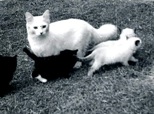

You, like me, may have come across some very
strong opinions concerning cats called mink Ragdolls.
I found people writing to forums wondering if they
had been scammed because they had a “mink Ragdoll”.
I was confused until I looked into the genetics of the Ragdoll, history of the breed which started in the 60’s
and talked directly with a TICA representative.
This page offers excerpts from both sides of the Ragdoll question as I found them, posted on the internet . For the privacy of breeders I have removed all breeder and cattery names. All punctuation and type emphasis remains as it was originally written.
My intention is to air the issue in a simple format.
This is by no means an exhaustive look into every point of every breeders stand. That would be exhausting!
I encourage all who read this to search the matter out in detail. I made my decision based on gathering facts and considering the opinions.
What Am I?
Blue mink kitten .
It all starts with history ___________________________________
______________________________________________________________________________
Josephine ?
______________________________________________________________________________
The “Breed standard” that is being called Ragdoll by those opposed to minks was developed from cats bought from Ann Baker’s Ragdolls. Dayton, who got into breeding Ragdolls as a business ended up breaking away from Ann Baker.
His “standard” is the developed off shoot of Ragdolls from the original Ragdolls of Ann Bakers Raggedy Ann cattery, which included minks.
According to one breeder Denny Dayton makes it his wish that minks are NEVER admitted into the standard. Unavoidable fact: Denny’s genetic stock originates from Bakers and what is now called “mink” is at the foundation of the line. Mink is not a new type or a Ragdoll look alike.
He has chosen to breed the mink gene out of the Ragdolls in his standard.
Purposefully selecting out the beautiful mink feeling fur for rabbit feeling fur.
______________________________________________________________________________
This breeder represents the case for minks as Ragdolls and gives information
to qualify their stand...
____________________________________________________________________________

The Ragdoll breed was developed by Ann Baker in Riverside, CA. the foundation cat of the breed was an ordinary non-pedigree cat called Josephine. It originated in 1964 with the first kittens being named as Ragdolls in 1965.
Ann borrowed from her neighbors, the Pennels, a cat that had the appearance of the Sacred Cat of Burma. She bred this cat to Josephine who was a white angora cat and produced Daddy Warbucks. Ann also acquired Josephine's daughter, Buckwheat, from the Pennels. Ann mated Daddy Warbucks to Josephine, the foundational female, and produced Fugianna.
From 1965-1969, Ann appeared to build up and increase her breeding stock. The first record of Ragdolls being sold is in early 1969 when Denny and Laura Dayton bought a breeding pair of Ragdolls from Ann Baker. They named the cats Buddy and Rosie.
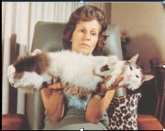
A highly complex breeding policy formulated by Ann Baker had to be rigidly adhered to, otherwise registration of the kittens would not be forthcoming and the kittens could not be called Ragdolls. Despite the strictures of the franchise, a number of interested breeders 'joined up', notably Laura and Denny Dayton in 1969.
Some websites state the franchise rules were started after the Daytons were breeders under Ann Baker.
Breeding from Raggedy Ann Buddy and Raggedy Ann Rosie, the Daytons were amazed when Ann Baker attempted to get more money from them when the time came for the kittens to be sold. She wanted $5.oo from each kitten sold.
Court actions ensued and as other franchisees found Ann Baker's demands too onerous, the Daytons acquired more Ragdoll cats. Finally the franchise was legally broken. However, the battles had taken their toll on Denny and Laura and so by 1980 they were ready to pass the flame to the next runner.
Then the rift:
The name 'Ragdoll' was trademarked by Ann Baker and anyone wishing to breed them could only do so on the basis of a franchise with registration through Ann Baker's own International Ragdoll Cat Association.
Blue point mink and blue pointed traditional kittens born into the same litter from the same father and mother.
The mink are born with color .
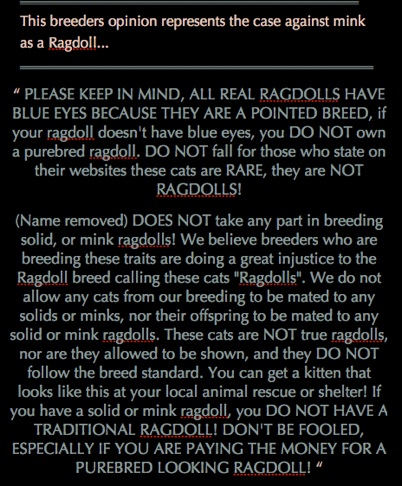
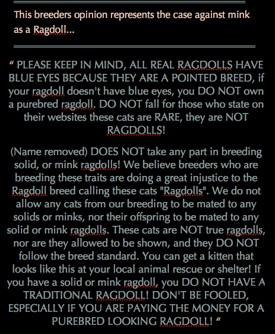
This is an excerpt from a breeder who met Denny at a cat show.
__________________________________________________________________
... But the real gift of all was having Denny Dayton there; he is one of the very 1st developers of the Ragdoll breed...
Oh, how I thoroughly enjoyed and cherished his company! He spent the entire weekend with us; at the seminars, in the show hall with us individually and as a group, and at the banquet...
He sat and told us story after story about his experiences to get our precious Ragdoll breed into the cat associations! He made his wishes clear that he NEVER wants to see the solid/self-colored or mink Ragdolls to be allowed into our Ragdoll Standard.
He said it would destroy all of the hard work everyone has done.
I pray all of the Ragdoll breeders will want to hold onto the dream that he always intended.
____________________________________________________________________________

Daytons
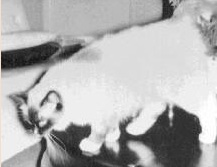
Mink Ragdolls are NOT a separate breed; they differ in only a few aspects of appearance. The temperament is the same.
Mink Ragdolls have been around since the beginning of the Ragdoll breed. YES, minks are purebred, SBT and TICA registered Ragdoll cats. A look at early pedigrees from the Ann Baker cattery, called Raggedy Ann, you will see the names of such Ragdoll cats as Josephine (a solid white Persian or Angora), and Buckwheat (a black Burmese-type cat) which confirm this statement.
The Burmese gene is cb which creates a brownish coat for a genetically black cat. The points (face mask, ears, legs and tail) are very dark and the rest of the body is richly warm. The mink gene isn’t a separate gene, but rather a combination of the pointed gene and the Burmese gene represented by (cbcs).
When you breed two mink Ragdoll cats together you’ll get the following results:
1Half of the litter will be mink colored
2A quarter will be “sepia” colored (actually this is Burmese color, but they are called “sepia”)
3A quarter will be pointed Traditional Ragdolls.
This is possible because some kittens will receive the cb gene from both parents, which will make them a sepia color, some will get the cs gene from both parents, which will make them pointed, and some will get cb gene from one parent and cs gene from the other, and so they are mink colored.
Mink is not a new breed of Ragdoll (nor even a new pattern), but rather it is a bloodline which can be traced back to the very first Ragdolls produced by Ann Baker and other IRCA Ragdoll breeders.
__________________________________________________________________________________
Most breeders today choose to solely continue with the pointed colors. Only a handful are devoted to continuing with these old lines and breed with Mink and Solid Ragdolls.
Do Mink and solid Ragdolls still have the same characteristics as the traditional variety of Ragdolls?
Most Most definitely!! They are a large, docile, floppy, people-friendly cat. The Ragdoll cat or kitten does not wish to be left alone, it is a very social creature. Other than having different markings, an SBT purebred TICA registered Mink or solid Ragdoll is exactly that, a True Ragdoll !!
_______________________________________________________________________________
_______________________________________________________________________________
To answer the question about competitions and showing the mink Ragdoll this breeder answers on their web page...
__________________________________________________________________
What "Pointed" means... All Ragdoll cats must be pointed cats with blue eyes to be acknowledged for championship competition. The Ragdoll is a pointed breed, which means that the body is lighter in color than the points (the face, legs, tail and ears). Two interesting things to know... If the eyes are not blue, they are NOT traditional ragdolls; and if they are not born WHITE, they are not traditional Ragdolls. Right now, these Ragdolls are the only ones allowed to show in the class. However, their are other ragdolls, the blue-eyed white, the mink and the sepia ragdoll, which are being shown in the household class, and may one day be allowed in Championship competition.
_______________________________________________________________________________
To answer the question about what the difference is between the Pointed Traditional and Pointed Mink Ragdoll cats this breeder wrote...
_______________________________________________________________________________
They are called “Mink” because the fur of this type of Ragdoll is still smoother than that of the pointed Traditional Ragdoll. It may seem to hardly be possible, but they truly feel like a ladies mink stole or a cashmere rabbit – incredibly soft.
Mink Ragdoll Kittens are born with color (yes full color, not white). The point color of the mink is much stronger, richer and darker than that of the traditional Ragdoll.
Now I hear you asking, “What colors and patterns are available in this type of Ragdoll?” Mink Ragdolls come in all the traditional colors of seal, blue, chocolate, lilac, flame, cream, tortie and blue/cream.
Eye color, however, between the traditional pointed variety, the Mink Ragdoll and the Solid Ragdoll are a distinguishing feature. In the traditional Ragdoll kitten, the eye color is always blue. The Mink Ragdoll has a gorgeous blue or aqua (blue-green) eye coloring, resembling those pictures of the Caribbean Sea.
_______________________________________________________________________________
FACT: TICA and SBT give official papers to Mink Ragdolls - they are PUREBRED and they are issued papers as Ragdolls without clauses or distinctions.
____________________________________




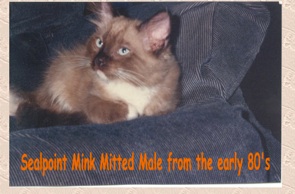
___________________________________________________________________________
One breeder had this post...
Here is a photo of a seal mink mitted male
from the early 80's. It came out of cats
we purchased from Ann Baker.
The opinions expressed on this page are those of other breeders
and not necessarily those of

